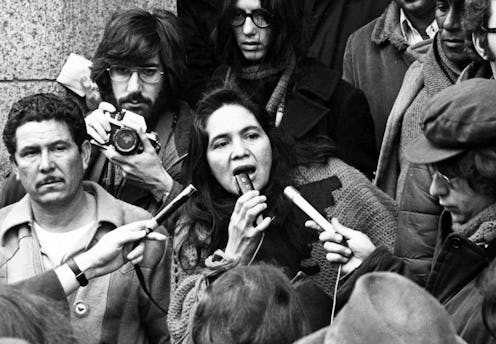Entertainment
How Gloria Steinem & Dolores Huerta Championed Intersectionality In Activism

Dolores Huerta is probably one of the most influential activists you've never heard of. Lucky for us, a new documentary, Dolores, aims to bring her accomplishments into the spotlight. For those of you who don't know, Huerta became an activist in the '50s, making a name for herself as one of the top activists fighting alongside César Chavez to start the National Farm Workers Association. As a young activist, Huerta was focused on the non-white (majority Mexican) farm workers in California — that is until she met Gloria Steinem in the 1960s and discovered her place in the feminist movement. Together, Steinem and Huerta championed intersectionality in activism, something they continue to do today.
As seen in this exclusive clip from Dolores, out Sept. 1, when Huerta first emerged into the world of activism, she was focused on a single cause: the farm workers of California. Even as she traveled to New York City in the midst of the National Boycott of California Table Grapes in the '60s, which began as a strike for the right to a minimum wage, and saw the growth of the feminist movement, she wasn't extremely interested. "My mind was focused on getting those women at those conventions to support the farmworkers," Huerta says in the clip. Fellow activist Angela Davis adds that the feminist movement "was assumed to be a question simply of gender. And if it was a question simply of gender, that gender was white."
This gap between Huerta's main fight for workers' rights and the feminist movement lessened as both Huerta and Steinem embraced the intersectionality in their movements. Huerta became more of a feminist as Steinem lent her voice to the National Boycott of California Table Grapes. Speaking of her relationship with Steinem in an interview with the Santa Barbara Independent, Huerta declared herself "a born again feminist." In that same interview, the activist revealed that, while many women were active in the farm workers strikes and boycotts, when actual change was made, she saw few women actually get a seat at the table. "When my epiphany came is when I started seeing that within the movement, once everything kind of got settled down, and all the women who had been on the front lines and on strike — all of a sudden you look around and where are the women?"
By incorporating feminism more consciously into her fight for workers' rights, Huerta was able to make more change and impact the way female workers were treated. Similarly, by expanding the feminist movement to be more aware of racial issues, like the farm workers, Steinem made efforts so that feminism was not just for white women. Intersectionality is vital to any social movement, and it's something that bears repeating today. In a world where activism has become not just a right but a moral imperative, it's important to recognize that we won't get very far on our own. Creating barriers between movements that share a goal of social justice won't do us any favors, and so we can all learn from Steinem and Huerta's truly important actions.